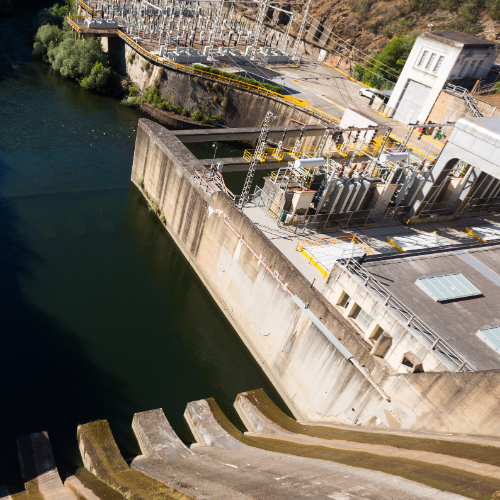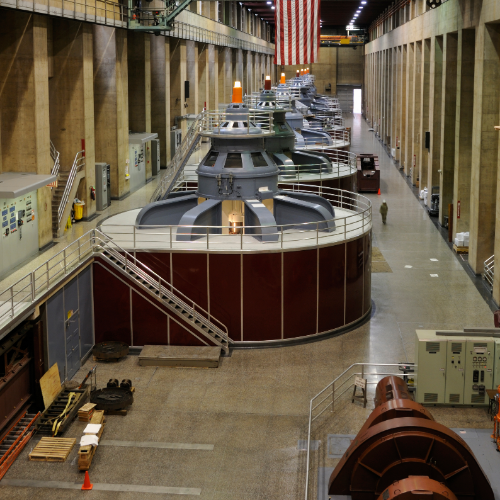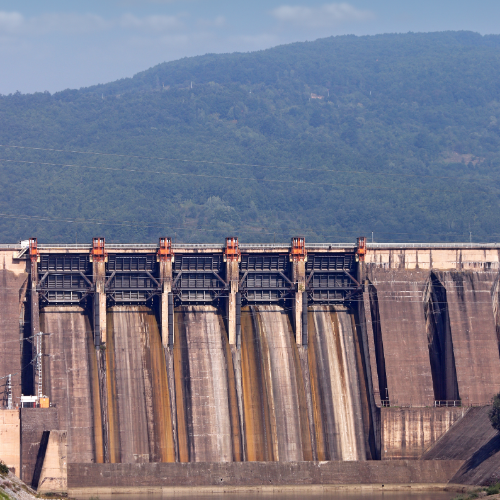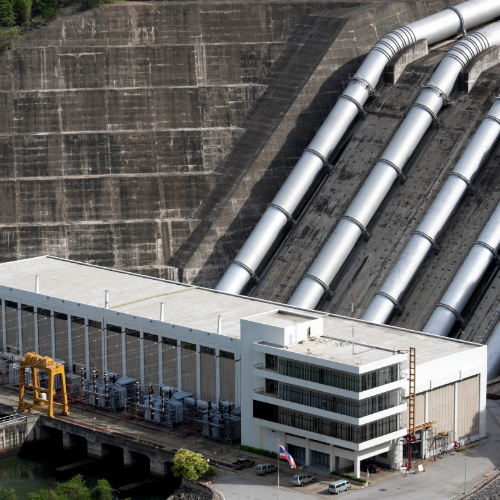HYDRO
HYDROELECTRIC POWER (HEP)
Hydroelectric power (HEP) is electricity generated from water that is moving due to the force of gravity. HEP schemes can range from a very small scale single turbine on a small stream. Small scale HEP systems are called micro hydroelectric power systems. An example of where this can be done is having a small turbine on a stream to generate power for a village or homestead that are far away from the national grid system.
Large scale HEP projects consist of a large dam or concentrated body of water, a significant and concentrated change in height from where the water is stored and a turbine. Finally, the generator set to make electricity and the transmission wires to connect the electricity to the grid.
Read More
How does HEP work?
- Moving water pushes turbines (which look like windmills or propellers) – usually located at the bottom of a dam wall. These turbines are connected to magnets and coiled wires (like a dynamo), and the spinning magnet generates an electric current. Water can move either by falling from the top of a dam wall through a tunnel, or naturally in the main channel of a river or stream (it moves due to the slope of the land).
- HEP systems can also be installed at the bottom of waterfalls, where the force of the falling water can spin the turbines located just under the water surface.
What are the components in hydroelectric power systems?
- The parts involved in an HEP system depend on its size. Generally, HEP is not stored in batteries, it is fed directly into a grid where it is distributed and used right away. In small systems, the turbines may be connected to batteries. Generally, these batteries will need to be connected to an inverter that will convert the direct current (DC) power into alternating current (AC) power which is what we use conventionally.
Sometimes reservoirs of water are built above the turbines in large scale HEP systems to store potential energy (so the reservoir of water itself is actually the battery). In some cases, when HEP is generated, some of the power that is generated when there is low demand for power is used to pump water up to reservoirs. Then the water from the reservoirs falls back through the turbines when power demand in the area is high (peak times). These systems are called pumped storage systems. The pumped hydro venture Snowy 2.0 in Southern NSW will pump water uphill into dams and release it when electricity demand is high. It will act as a giant battery, backing up intermittent energy from by wind and solar.
What are the advantages of HEP?
- Can be generated consistently (both day and night)
- Water storage systems often have other uses apart from HEP eg. tourism, fishing, irrigation
What are the disadvantages of HEP?
- Water storage systems are generally reliant on a region’s precipitation and therefore its seasons
- Storage systems may receive precipitation that comes from outside the country’s borders. This makes water bodies vulnerable to climatic extremes and variations outside the country where the reservoir is eg. droughts and The Mekong River is an example of this flowing through several countries and Laos intention to develop many HEP projects along the rivers journey in Laos.
- Building dams has major social and ecological consequences relocation of communities, flooding of natural habitats
- There are a limited number of suitable places for building dams around the world (meaning there is a limited possibility to expand – because most suitable sites already have dams built on them)
- The suitability of countries for developing HEP ranges considerably, as finding a suitable site is dependent on climate, relief, geology etc.
- Dams are expensive to build and require significant skills, finance and maintenance in order to be secure (eg. fixing cracking walls)
- Flooding during dam building means vegetation gets submerged. As it is smothered, it begins to decompose, and this releases methane. Methane is one of the most potent of the greenhouse gases, meaning that it contributes more than other greenhouse gases to the warming of the atmosphere. This can contribute to the enhanced greenhouse effect, and unnaturally high amounts of greenhouse gases contribute to increased warming of the atmosphere.
How does using HEP help me to reduce my carbon footprint / carbon emissions?
- Generally HEP projects on dams are able to generate large amounts of power, meaning that a single HEP project can feed significant amounts of power into the national grid. This reduces the amount of fossil fuels that a country needs to burn to cater for their total energy demands.
- The choices a country makes for the types of fuels it uses for generating power is called their energy mix. The greater the proportion of the mix that is made up from renewables, generally the lower the amount of carbon emissions there are per person from the production of each kilowatt of power. In Australia for example, about 5 to 7% of the country’s total energy mix comes from HEP, and HEP contributes a large proportion of all the renewables. Costa Rica, on the other hand, had almost 78% of its energy generated from HEP in 2017 (for most of the year). However, the two countries have significantly different populations and power demands – Costa Rica, with a small total population relative to Australia, was supplied almost entirely by a single dam.
HEP in Australia
There has been an ongoing drought in Australia, which has reduced the ability of HEP to contribute as significantly as before to Australia’s energy production. Nevertheless, HEP contributed about 6.5% of Australia’s total electricity production in 2019. This was 14 166 GWh (Gigawatt hours) and made up approximately 25% of all renewable energy generated in Australia.
Read Less




Hydro




HYDROELECTRIC POWER (HEP)
Hydroelectric power (HEP) is electricity generated from water that is moving due to the force of gravity. HEP schemes can range from a very small scale single turbine on a small stream. Small scale HEP systems are called micro hydroelectric power systems. An example of where this can be done is having a small turbine on a stream to generate power for a village or homestead that are far away from the national grid system.
Large scale HEP projects consist of a large dam or concentrated body of water, a significant and concentrated change in height from where the water is stored and a turbine. Finally, the generator set to make electricity and the transmission wires to connect the electricity to the grid.
Read More
How does HEP work?
- Moving water pushes turbines (which look like windmills or propellers) – usually located at the bottom of a dam wall. These turbines are connected to magnets and coiled wires (like a dynamo), and the spinning magnet generates an electric current. Water can move either by falling from the top of a dam wall through a tunnel, or naturally in the main channel of a river or stream (it moves due to the slope of the land).
- HEP systems can also be installed at the bottom of waterfalls, where the force of the falling water can spin the turbines located just under the water surface.
What are the components in hydroelectric power systems?
- The parts involved in an HEP system depend on its size. Generally, HEP is not stored in batteries, it is fed directly into a grid where it is distributed and used right away. In small systems, the turbines may be connected to batteries. Generally, these batteries will need to be connected to an inverter that will convert the direct current (DC) power into alternating current (AC) power which is what we use conventionally.
Sometimes reservoirs of water are built above the turbines in large scale HEP systems to store potential energy (so the reservoir of water itself is actually the battery). In some cases, when HEP is generated, some of the power that is generated when there is low demand for power is used to pump water up to reservoirs. Then the water from the reservoirs falls back through the turbines when power demand in the area is high (peak times). These systems are called pumped storage systems. The pumped hydro venture Snowy 2.0 in Southern NSW will pump water uphill into dams and release it when electricity demand is high. It will act as a giant battery, backing up intermittent energy from by wind and solar.
What are the advantages of HEP?
- Can be generated consistently (both day and night)
- Water storage systems often have other uses apart from HEP eg. tourism, fishing, irrigation
What are the disadvantages of HEP?
- Water storage systems are generally reliant on a region’s precipitation and therefore its seasons
- Storage systems may receive precipitation that comes from outside the country’s borders. This makes water bodies vulnerable to climatic extremes and variations outside the country where the reservoir is eg. droughts and The Mekong River is an example of this flowing through several countries and Laos intention to develop many HEP projects along the rivers journey in Laos.
- Building dams has major social and ecological consequences relocation of communities, flooding of natural habitats
- There are a limited number of suitable places for building dams around the world (meaning there is a limited possibility to expand – because most suitable sites already have dams built on them)
- The suitability of countries for developing HEP ranges considerably, as finding a suitable site is dependent on climate, relief, geology etc.
- Dams are expensive to build and require significant skills, finance and maintenance in order to be secure (eg. fixing cracking walls)
- Flooding during dam building means vegetation gets submerged. As it is smothered, it begins to decompose, and this releases methane. Methane is one of the most potent of the greenhouse gases, meaning that it contributes more than other greenhouse gases to the warming of the atmosphere. This can contribute to the enhanced greenhouse effect, and unnaturally high amounts of greenhouse gases contribute to increased warming of the atmosphere.
How does using HEP help me to reduce my carbon footprint / carbon emissions?
- Generally HEP projects on dams are able to generate large amounts of power, meaning that a single HEP project can feed significant amounts of power into the national grid. This reduces the amount of fossil fuels that a country needs to burn to cater for their total energy demands.
- The choices a country makes for the types of fuels it uses for generating power is called their energy mix. The greater the proportion of the mix that is made up from renewables, generally the lower the amount of carbon emissions there are per person from the production of each kilowatt of power. In Australia for example, about 5 to 7% of the country’s total energy mix comes from HEP, and HEP contributes a large proportion of all the renewables. Costa Rica, on the other hand, had almost 78% of its energy generated from HEP in 2017 (for most of the year). However, the two countries have significantly different populations and power demands – Costa Rica, with a small total population relative to Australia, was supplied almost entirely by a single dam.
HEP in Australia
There has been an ongoing drought in Australia, which has reduced the ability of HEP to contribute as significantly as before to Australia’s energy production. Nevertheless, HEP contributed about 6.5% of Australia’s total electricity production in 2019. This was 14 166 GWh (Gigawatt hours) and made up approximately 25% of all renewable energy generated in Australia.
Read Less
Hydro
Increasing numbers of corporate and holidaymakers want to travel sustainably, and prefer environmentally aware providers when booking accommodation, events, and venues. The expectations of consumers have changed, and for the hotel industry, adapting to these changes is not only smart business but a strategic imperative.
Tourism is one sector with the biggest potential in the world. In Australia, the hotel and resort sector generates around $8 billion of revenue yearly. With this comes a large carbon emissions footprint, that needs to be acknowledged, measured and a strategy developed to reduce it. It is necessary to provide transparent information and a plan to the consumers who are also on the journey to carbon neutrality.
Read More
Currently, the hotel and resort industry faces the challenge of sustainability. How can we reduce our carbon footprint? Carbon Offset Advisory can help you understand the issues, the process and guide you through a strategic approach to improvement in environmental performance using progressive steps.
You need a plan to reduce resource consumption, improve efficiency, manage waste, control pollutants, use sustainable products, recycle and transition to carbon neutral suppliers.
To achieve this, we focus on several key areas:
- Commit, Measure and Act
- Empowering you with information that facilitates decision making.
- Decarbonise your supply chain.
- Using environmental performance and industry leadership as a positive marketing tool to grow business.
- Strategic implementation to minimise disruption and cost.
Carbon Offset Advisory develops achievable plans and strategies that will lead you to NET ZERO CARBON with minimal cost and disruption.
Read Less







